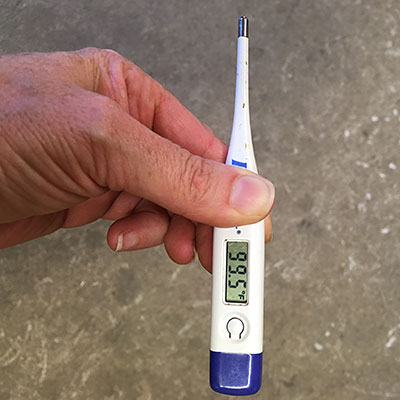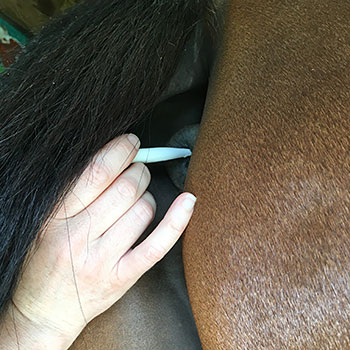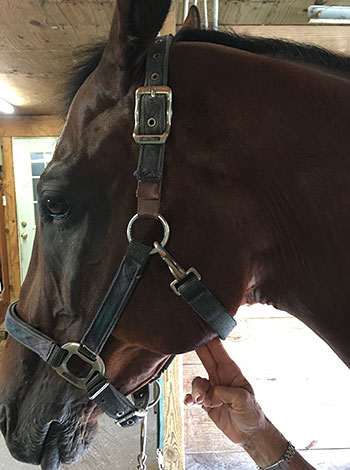Fact Sheet FS1262

Figure 1: Digital thermometer with a normal reading for a horse.
Taking your horse's temperature, pulse, and respiration can provide valuable information about a horse's general state of well-being. It's a quick and easy way to determine how your horse is feeling. The next time you speak to your veterinarian about a horse health concern, providing this simple data will be very helpful.
Temperature
It is important to take your horse's body temperature periodically to determine what is normal for him/her. Veterinary thermometers are easy to find and inexpensive to purchase. Digital or mercury thermometers will both work.
Keep a small supply of petroleum jelly or other lubricant and spread a light layer along the lower half of the thermometer. While standing beside the horse's hind end and out of the way of a potential kick, carefully grasp the base of the tail and lift it to the side. Then, very gently, insert the thermometer into the horse's rectum. Do not force the thermometer into the rectum! Continue to hold the thermometer securely to prevent it from going too far or falling down to the ground (see Figure 2). Leave the thermometer in place until an audible signal sounds (digital models) or for 2–3 minutes (mercury thermometers). Read the temperature. If it falls between 99–101°F, your horse is in normal range.

Figure 2: Measuring a horse's rectal temperature.
If your horse has been at rest before the temperature was taken and the temperature is higher (or lower) than 99–101°F, call your veterinarian immediately. Note that it is normal for a horse's temperature to rise during and immediately after exercise, but it should return to normal fairly quickly.
Pulse
Pulse is a measure of heart rate. Before taking a pulse, have a watch, stopwatch, or smart phone with a timer handy so you can keep track of seconds while counting heartbeats.
An easy way to feel a horse's pulse is by placing your fingers (not thumbs!) under the bottom jawbone, toward the neck and under the cheek (see Figure 3). You should feel a large vein-like structure that moves around—the vein will feel like a small pencil or string under the skin. Its exact placement will differ from horse to horse, but is always in the same general area. Apply gentle pressure so that you can feel the "bounce" or pulsation of blood within the vein. Once you find the pulse, start the stopwatch. Count the pulse for 15 seconds, then multiply the number you get by 4. (Example: I counted 12 beats in 15 seconds. 12 x 4 = 48. So the heart is beating approximately 48 times per minute.)

Figure 3: Assessment of a horse's pulse using two fingers under the cheek.
Alternatively, if you have a stethoscope you can hear the horse's heartbeat from the left side, right behind the elbow, around the area where the girth of a saddle would lie. The process here is the same. Once you hear the "lub-dub" of the heartbeat, check your watch and count for 15 seconds then multiply by 4 to get the beats per minute.
A normal heart rate for an adult horse ranges from 28–48 beats per minute. Larger breeds are on the lower end of the range, while smaller horses tend to be on the higher end. Newborn foals will have a higher heart rate, ranging from 80–120 beats per minute, while yearlings range from 40–60 beats per minute.
Respiration
Respiration refers to the inhalation of oxygen and the exhalation of carbon dioxide and water vapor from the lungs. Measurement of respiration rate is fairly simple. Make sure the horse is relaxed either in a stall or on crossties. Stand quietly by the horse's side, facing toward the ribcage area. Passively observe the rise and fall of the ribs or flank area. Keep your timer handy. Mark the time and count the number of breaths over at least 15 seconds. Multiply the number of breaths by 4 (3 breaths x 4 = 12 per minute). The normal respiration rate for a horse at rest is approximately 8–14 breaths per minute, give or take a breath or two. Alternatively, place your hand a few inches from the horse's nostril (see Figure 4). The horse may sniff you at first, so wait until he's done checking you out and resumes breathing normally to begin counting breaths. Note that some horses become distracted with a hand by the nose, making it more difficult to get accurate count versus the former method.

Figure 4: Placement of the hand in front of the horse's nostril to measure respiration rate.
Respiration rate will quickly increase when the horse begins to move. During intense exercise, respiration rate can increase as high as 120 breaths per minute. Breathing rate should begin to decline towards normal as soon as exertion stops. Interestingly, the ratio of heartbeats to breaths in horses is 4:1. For every 4 heart beats, the horse takes 1 breath. If this ratio becomes altered or reversed, veterinary attention is sometimes needed.
Summary
It is important to monitor your horse's TPR on a routine basis. The information obtained from these examinations provides valuable information for the horse owner and veterinarian alike. Alterations in these values can indicate abnormalities such as infection, pain, or distress, just to name a few. Your veterinarian can help interpret the results from your TPR examination.
References
November 2016
Copyright © 2024 Rutgers, The State University of New Jersey. All rights reserved.
For more information: njaes.rutgers.edu.
Cooperating Agencies: Rutgers, The State University of New Jersey, U.S. Department of Agriculture, and Boards of County Commissioners. Rutgers Cooperative Extension, a unit of the Rutgers New Jersey Agricultural Experiment Station, is an equal opportunity program provider and employer.

